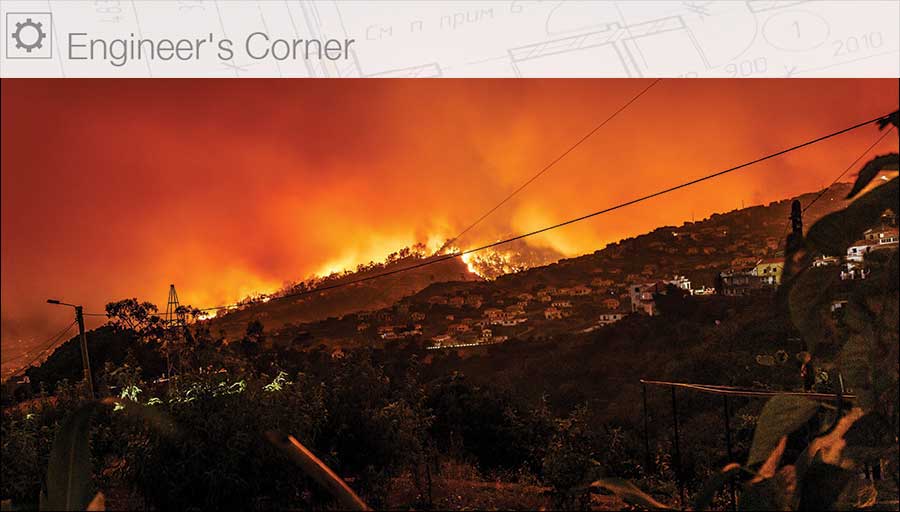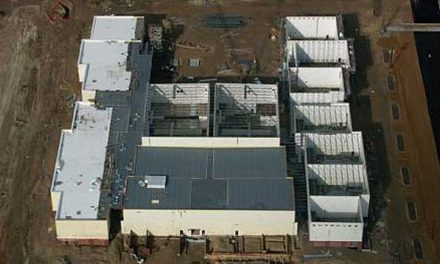By Dave Gowers
ICF construction is extremely suitable to resist natural disasters and extreme environmental conditions. It can resist high winds, high Richter scale seismic events, and wildfires. Several events have taken place again this year in mainland USA and offshore locations. The following explains some of these events, and why ICF construction is an excellent choice to survive these extreme conditions.
Fire Season
Here in southern Oregon, last year’s fire season was a bit longer than usual due to the dryer and hotter conditions. Fire season began on June 1 and will finish around October 16. During this extended fire season, we experienced a major forest fire close by — around 25 miles away. The fire grew to become named the Smith River Complex, and by the time it was fully contained, it had grown to 95,000 acres. It started from a lightning strike in a small area in steep canyon country on Route 199 in Northern California, at a location known as Patrick’s Creek. Because of the steep terrain, and the amount of smoke it generated, it was neither accessible by ground crews nor helicopter crews. So for the first few weeks, it was uncontainable. It grew to several thousand acres very rapidly and expanded into southern Oregon.
The well-known Patrick’s Creek Lodge motel and restaurant at Patrick’s Creek, which is somewhat of a local landmark, was in great danger of being burned down. In addition, several surrounding localities were evacuated, and several more were put on get-ready-to-evacuate alert status. I’m pleased to report that, thanks to the efforts of the firefighters, the lodge was preserved, and many structures that would otherwise have perished, were preserved! The direction of the prevailing wind would determine whether we would be put on evacuation alert — we were approximately northeast of the fire. Thankfully, for us at least, the prevailing wind mostly came out of the northeast, so that not only kept the fire at bay, but other than an exception of three or four days, we were also without smoke.
I’m sharing the above to illustrate how vulnerable we are to wildfire incidents. While no building materials are 100% fireproof, ICF construction is non-combustible and therefore is extremely fire-resistant. It is therefore eminently suitable for residential and commercial construction in all areas, but particularly so in areas subject to wildfires. The foam used in ICFs will not burn. It will melt if exposed to high enough temperatures, but it will not contribute any fuel to the heat source, such as a close proximity wildfire. In fact, it is virtually self-extinguishing as a result of the flame retardant added to the EPS foam by all the leading ICF manufacturers. As public awareness of ICF construction increases, and fire destruction rebuilds appear to be with us more and more, we are seeing many of these rebuilds being designed as ICF rather than wood-frame. This is extremely encouraging!
Hurricanes and Typhoons
Other natural disaster categories that seem to have been prolific this year are hurricanes and typhoons. Several have hit mainland USA and the Pacific islands hard. One such event, Typhoon Mawar, hit Guam back in May 2023. With winds of more than 140 mph and 28 inches of rain, there were many residential failures. In fact, more than 1,400 homes were either substantially damaged or destroyed. The current building code design wind speed for Guam is 195 mph with 3-second gusts. ICF construction is an excellent choice to resist this design wind speed. I have provided several structural packages for Guam-based projects. I’m pleased to report that those under construction, or have been completed, suffered negligible damage from Typhoon Mawar, and no damage at all to the building envelope.
A 6-inch concrete core ICF wall is approximately 10 times stronger in shear than well-sheared wood-frame construction. It will also be far more securely anchored to the foundation, as a result of the continuous rebar connection versus localized hold-downs used in wood-frame construction. Consequently, higher resistance to wind shear forces is easily achieved using ICF construction.
Seismic Events
Seismic events are prolific along the western seaboard of the USA, from California all the way up through Alaska. In a new Uniform California Earthquake Rupture Forecast (UCERF) study by the US Geological Survey (USGS), the estimate for the likelihood that California will experience a magnitude Richter 8 or larger earthquake in the next 30 years has increased from about 4.7% (UCERF2) to about 7.0% (UCERF3). If this is indeed accurate, and there’s no reason to think otherwise, California will likely experience an earthquake of catastrophic proportions in the next 30 years. The Northridge earthquake of 1994 had a rating of Richter 6.9. That was immensely catastrophic, having destroyed several freeway overpasses and hundreds of residential and commercial buildings. I personally performed more than 650 post-seismic structural inspections following that event — it was devastating to see the aftermath of such a colossal natural disaster.
Interestingly enough, the concrete structures I inspected withstood the seismic forces better than steel-framed structures, and wood-framed structures performed appallingly. There is no doubt in my mind that had ICF structures been predominant in Northridge back in 1994, the resulting magnitude of damage would have been substantially reduced, with fewer insurance claims, and a substantial reduction of repair costs.
In conclusion, it is evident that ICF construction can withstand natural disasters significantly better than other types of construction. Whether the disaster emanates from wind, fire, or seismic sources, ICF construction has demonstrated its capability to perform exceptionally well, with minimal damage. I truly hope that over the coming years, codes, insurance carriers, and financial lenders will become more aware of this capability, and as a result, designers and engineers will be more inclined to adopt ICF construction, especially in high-risk locations.

Dave Gowers
In the 51 years since graduating from London University in the United Kingdom, Dave Gowers has acquired extensive experience in concrete construction through diverse commercial, residential, and industrial projects, up to $1-billion in value, in several countries. Dave resides in Southern Oregon with his wife and business partner,
Jennifer. Dave holds a PE license in 14 states/territories and is the principal of Dave Gowers Engineering LLC, and co-principal of Cascade ICF LLC. He can be reached at 541-660-9661 or
dave@dgengineering.com.







